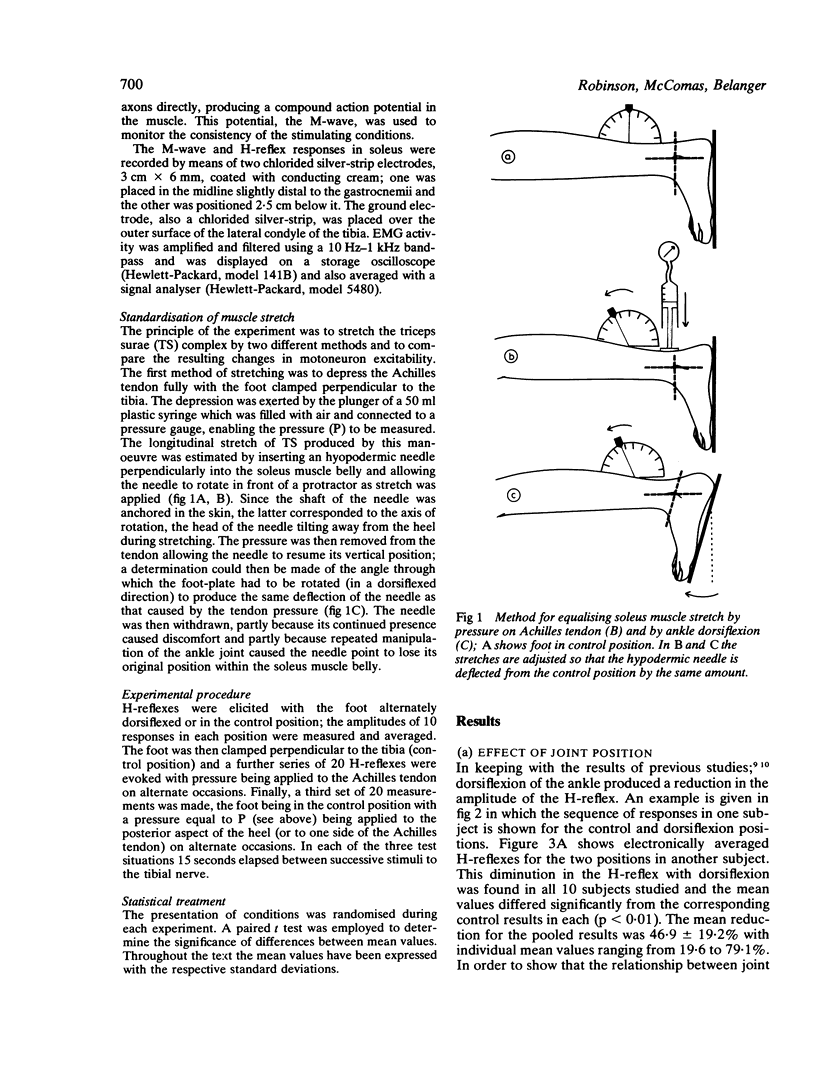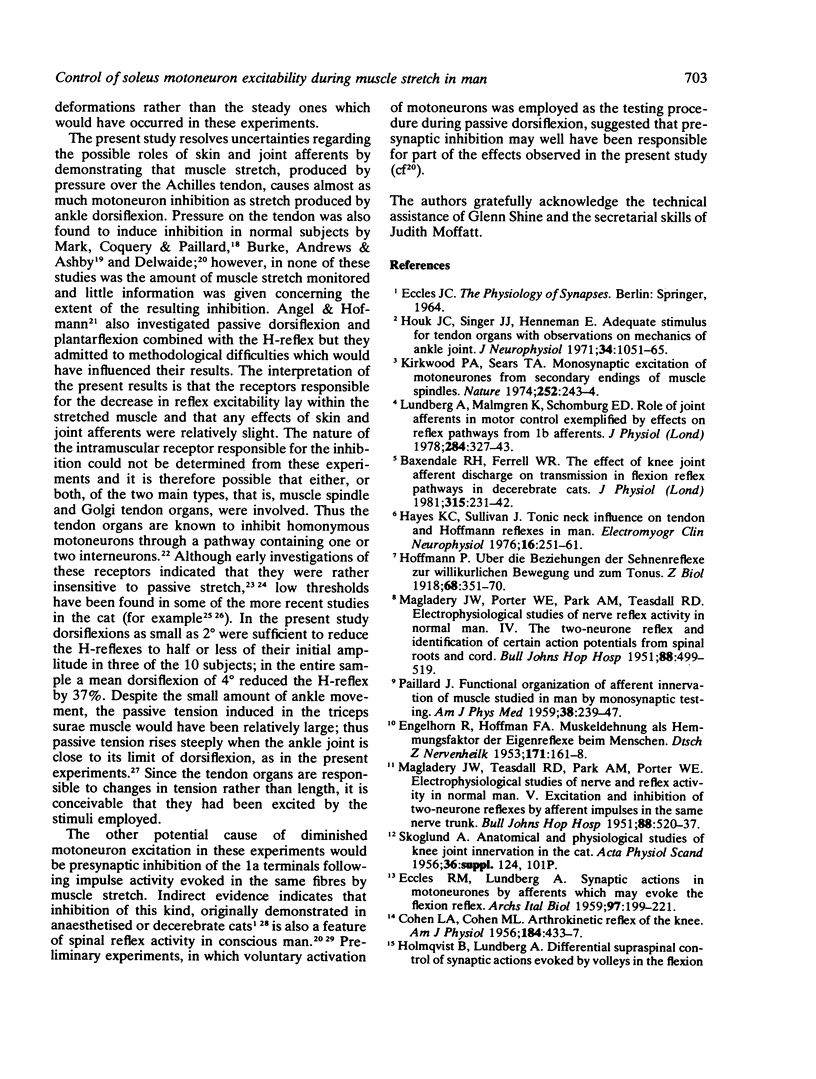Abstract
The relative contributions of intramuscular and extramuscular receptors to changes in the reflex excitability of soleus motoneurons, following muscle stretch, have been studied in man. It was found that reflex excitability was decreased by muscle stretch. The extent of the decrease was related to the amount of stretch, irrespective of whether the latter was produced by dorsiflexion of the ankle or by depression of the Achilles tendon with the ankle joint fixed. The results were unaffected by anaesthesia of the skin. It would appear that neither joint receptors nor cutaneous mechanoreceptors contribute significantly to the decrease in reflex excitability during ankle dorsiflexion and that the intramuscular receptors are mainly responsible for the effects observed.
Full text
PDF





Selected References
These references are in PubMed. This may not be the complete list of references from this article.
- ANGEL R. W., HOFMANN W. W. THE H REFLEX IN NORMAL, SPASTIC, AND RIGID SUBJECTS. Arch Neurol. 1963 Jun;9:591–596. doi: 10.1001/archneur.1963.00460060021002. [DOI] [PubMed] [Google Scholar]
- Baxendale R. H., Ferrell W. R. The effect of knee joint afferent discharge on transmission in flexion reflex pathways in decerebrate cats. J Physiol. 1981 Jun;315:231–242. doi: 10.1113/jphysiol.1981.sp013744. [DOI] [PMC free article] [PubMed] [Google Scholar]
- Burgess P. R., Clark F. J. Characteristics of knee joint receptors in the cat. J Physiol. 1969 Aug;203(2):317–335. doi: 10.1113/jphysiol.1969.sp008866. [DOI] [PMC free article] [PubMed] [Google Scholar]
- Burke D., Andrews C., Ashby P. autogenic effects of static muscle stretch in spastic man. Arch Neurol. 1971 Oct;25(4):367–372. doi: 10.1001/archneur.1971.00490040093011. [DOI] [PubMed] [Google Scholar]
- Burke D., Ashby P. Are spinal "presynaptic" inhibitory mechanisms suppressed in spasticity? J Neurol Sci. 1972 Mar;15(3):321–326. doi: 10.1016/0022-510x(72)90073-1. [DOI] [PubMed] [Google Scholar]
- COHEN L. A., COHEN M. L. Arthrokinetic reflex of the knee. Am J Physiol. 1956 Feb;184(2):433–437. doi: 10.1152/ajplegacy.1956.184.2.433. [DOI] [PubMed] [Google Scholar]
- Caccia M. R., McComas A. J., Upton A. R., Blogg T. Cutaneous reflexes in small muscles of the hand. J Neurol Neurosurg Psychiatry. 1973 Dec;36(6):960–977. doi: 10.1136/jnnp.36.6.960. [DOI] [PMC free article] [PubMed] [Google Scholar]
- ECCLES J. C., ECCLES R. M., LUNDBERG A. Synaptic actions on motoneurones caused by impulses in Golgi tendon organ afferents. J Physiol. 1957 Sep 30;138(2):227–252. doi: 10.1113/jphysiol.1957.sp005849. [DOI] [PMC free article] [PubMed] [Google Scholar]
- ENGELHORN R., HOFFMANN F. A. Muskeldehnung als Hemmungsfaktor der Eigenreflexe beim Menschen. Dtsch Z Nervenheilkd. 1953;171(2):161–168. [PubMed] [Google Scholar]
- HUNT C. C., KUFFLER S. W. Stretch receptor discharges during muscle contraction. J Physiol. 1951 Apr;113(2-3):298–315. doi: 10.1113/jphysiol.1951.sp004573. [DOI] [PMC free article] [PubMed] [Google Scholar]
- Hayes K. C., Sullivan J. Tonic neck reflex influence on tendon and Hoffmann reflexes in man. Electromyogr Clin Neurophysiol. 1976 Apr-Jul;16(2-3):251–261. [PubMed] [Google Scholar]
- Houk J. C., Singer J. J., Henneman E. Adequate stimulus for tendon organs with observations on mechanics of ankle joint. J Neurophysiol. 1971 Nov;34(6):1051–1065. doi: 10.1152/jn.1971.34.6.1051. [DOI] [PubMed] [Google Scholar]
- Kirkwood P. A., Sears T. A. Monosynaptic excitation of motoneurones from secondary endings of muscle spindles. Nature. 1974 Nov 15;252(5480):243–244. doi: 10.1038/252243a0. [DOI] [PubMed] [Google Scholar]
- Lundberg A., Malmgren K., Schomburg E. D. Role of joint afferents in motor control exemplified by effects on reflex pathways from Ib afferents. J Physiol. 1978 Nov;284:327–343. doi: 10.1113/jphysiol.1978.sp012543. [DOI] [PMC free article] [PubMed] [Google Scholar]
- MAGLADERY J. W., PORTER W. E., PARK A. M., TEASDALL R. D. Electrophysiological studies of nerve and reflex activity in normal man. IV. The two-neurone reflex and identification of certain action potentials from spinal roots and cord. Bull Johns Hopkins Hosp. 1951 Jun;88(6):499–519. [PubMed] [Google Scholar]
- Mark R. F., Coquery J. M., Paillard J. Autogenetic reflex effects of slow or steady stretch of the calf muscles in man. Exp Brain Res. 1968;6(2):130–145. doi: 10.1007/BF00239167. [DOI] [PubMed] [Google Scholar]
- Matthews B. H. Nerve endings in mammalian muscle. J Physiol. 1933 Apr 13;78(1):1–53. doi: 10.1113/jphysiol.1933.sp002984. [DOI] [PMC free article] [PubMed] [Google Scholar]
- PAILLARD J. Functional organization of afferent innervation of muscle studied in man by monosynaptic testing. Am J Phys Med. 1959 Dec;38:239–247. [PubMed] [Google Scholar]
- Stuart D. G., Goslow G. E., Mosher C. G., Reinking R. M. Stretch responsiveness of Golgi tendon organs. Exp Brain Res. 1970 Jun 25;10(5):463–476. doi: 10.1007/BF00234263. [DOI] [PubMed] [Google Scholar]


